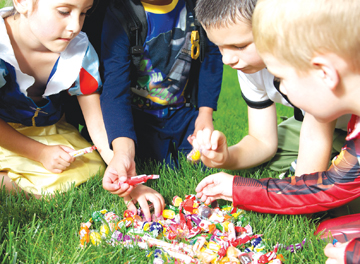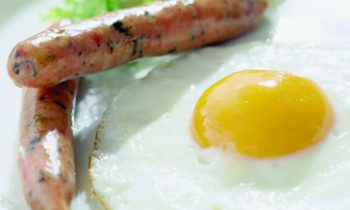Rainbow of food dyes in our grocery aisles has a darkside
By Lisa Kruger, Review Staff Writer
You’re spending a normal day with your child/grandchild, playing outside, running errands, etc. You stop to grab a treat, something like M&Ms®, Skittles®, a chocolate cupcake. Your once lovable, caring, good natured child in a flip of switch is no longer there. Instead, what you have is someone else taking over that child’s body & mind. They become destructive, spit, bite, scream, are hyperactive, defiant, unable to focus, and show many other behavioral problems. What happened? What could have caused this behavior? How do you make it stop? (In most cases it won’t for hours.)
Red Dye No. 40. This horrible petroleum based carcinogen is the culprit. Where is Red Dye No. 40 found? Fruit snacks, candy, cakes, frostings, cereals, processed foods, health & body products, medicines, beverages; the list goes on and on. Keep in mind, food does not need to appear red to have the Red Dye No. 40 in it, ex. glazed doughnuts.
 Red Dye No. 40 and many other dyes are widely used in the United States to attract children and adults to manufacturer’s products. If it doesn’t look fun, if the colors aren’t bright, they feel no one will buy them. The dyes are not found in fresh fruits or vegetables, they don’t need to look bright because they use their natural colors. If a food comes in an outrageous color that is not found in nature, consuming it is probably not a good idea. There is absolutely no health benefit to this ingredient whatsoever.
Red Dye No. 40 and many other dyes are widely used in the United States to attract children and adults to manufacturer’s products. If it doesn’t look fun, if the colors aren’t bright, they feel no one will buy them. The dyes are not found in fresh fruits or vegetables, they don’t need to look bright because they use their natural colors. If a food comes in an outrageous color that is not found in nature, consuming it is probably not a good idea. There is absolutely no health benefit to this ingredient whatsoever.
In 2010, European lawmakers passed a law that would require manufacturer’s to have warning labels on foods that contained artificial dyes. It warns parents that their child might become hyperactive and have attention problems if they consume that product. Many manufacturer’s (including the same one’s in the United States) have turned to natural dyes made from beets, paprika or tumeric. There are a few manufacturer’s in the U.S. who are slowly starting to switch some of their products over to natural colors. The reason for their slow progress; it is more expensive for them and less stable. What I have found in some stores is that Costco® will have a brand of fruit snacks with all natural colors, but this same brand & exact same product is sold in a smaller store in the U.S. with the artificial dyes in it. Why?
In the U.S., if you eat a Nutri-Grain® cereal bar, it will contain Red 40, Yellow 6 and Blue 1. The same exact cereal bar in the United Kingdom contains only the natural colorings from beetroot red, annatto & paprika extract.
In the U.K., all products made by Mars® use natural colorings. In the U.S., the full spectrum of artificial colors are being used in their products. McDonald’s® in the U.K. uses real strawberries in their strawberry sauce for their sundaes, in the U.S. it comes from Red Dye No. 40.
How is Red Dye No. 40 made?
If you’re ok with eating bugs, or putting fuel that we use in our cars in your body, then you should be ok with eating this dye. It is made from petroleum and cochineal insects. The bugs are found on the prickly pear cacti that are commonly found in the North American deserts. These bugs produce a bitter, crimson-colored pigment called “carminic acid,” which they store in their guts and use to ward off predators. To make the red dye, manufacturers dry the cochineals (bugs) and grind them into a powder. The powder then turns into a bright red color when mixed with water. Sounds appetizing…
Red Dye No. 40 has been around since the 1970’s and is also found under other names such as: Red 40, Allura Red AC, Red. No. 40, FD&C Red. No. 40, Allura Red, C.I. 16035, C.I. Food Red 17 and Red 40 Lake.
The Red 40, Yellow 5 & Yellow 6 Dyes contain benzidine which is a human and animal carcinogen. A carcinogen is any substance that is an agent directly involved in causing cancer!
FOOD MANUFACTURERS POUR 15 MILLION POUNDS OF ARTIFICIAL FOOD DYES INTO U.S. FOODS EACH YEAR.
The FDA (Food & Drug Administration) continues to allow these toxic ingredients in countless popular foods, including those marketed directly to children. Why are they still allowing this in the U.S.?
How are dyes affecting us?
A study found that the E-numbered food dyes do as much damage to children’s brains as lead in gasoline, resulting in a significant reduction in IQ.
The results of this study are what prompted the British Foods Standard Agency to issue an immediate advisory to parents, warning them to limit their children’s intake of additives if they notice an effect on behavior. The U.S., however, has not followed suit in issuing any similar warnings to American parents.
Kids’ brains absorb about 50% of what they eat. Food not only fuels the body, but also the mind. A number of studies have suggested that the additive of this artificial red dye negatively affects brain functioning and increases ADHD symptoms.
Other symptoms associated with the dye: destructive behavior, spitting, biting, chewing clothing, suicidal thoughts, inattention, hyperactivity, screaming/yelling, stomach aches, allergic reactions (hives), headaches, irrational behavior, as if someone else has taken over the child’s mind/body and cancer (in animal studies).
The bottom line is that no one NEEDS color in their diet. In the report “Food Dyes: A Rainbow of Risks” by The Center for Science in the Public Interest (CSPI) group, they revealed that nine of the food dyes currently approved for use in the U.S. are linked to health issues ranging from cancer and hyperactivity to allergy-like reactions. These results were from studies conducted by the chemical industry itself.
The washingtonpost.com reported that beyond the behavioral problems and cancer risks, the greatest hazard that dyes pose for children may also be the most obvious. They draw kids away from nutritious foods and toward brightly colored processed products that are high in calories, but low in nutrients, such as fruit-flavored drinks and snack foods. Those types of foods are a major force in America’s obesity epidemic.
The Feingold Diet
In the 1970’s Pediatrician/Allergist Dr. Benjamin Feingold presented evidence linking artificial food dyes to behavioral problems in children. Yet the FDA still does not require manufacturers to test dyes for developmental neurobehavioral toxicity – an alteration of attention, concentration, coordination, mood, muscle activity, neurological development, or sensation due to exposure to a poisonous chemical, drug, or physical agent.
Dr. Feingold introduced the Feingold Diet; a form of elimination diet where foods containing certain harmful additives are removed and replaced with similar foods that are free of those additives.
First, the diet is used as a diagnostic tool to determine if any of the eliminated items are triggering some or all of the problems you are seeing. When successful, it is continued as a treatment and can also be combined with any other necessary medical treatments. Foods eliminated: artificial food coloring (petrochemical dyes); artificial flavors and fragrances; three preservatives; artificial sweeteners; list of foods and products containing salicylate.
“The science shows that kids’ behavior improves when these artificial colorings are removed from their diets and worsens when they’re added to their diets,” said Dr. David Schab, a psychiatrist at Columbia University Medical Center. “While not all children seem to be sensitive to these chemicals, its hard to justify their continued use in foods – especially those foods heavily marketed to young children.”
How can you remove dyes from your child’s diet?
1. The simplest way to avoid having Red Dye in your diet. Read labels very carefully. Take the time to look at the ingredients label, if it has any dye that says “red” or names listed above, put it back on the shelf and look for an alternative.
2. Support companies that don’t use artificial food dyes. The less you use the products that do include dyes, the more they’ll be apt to changing over to natural coloring.
Your diet should consist of a range of vibrantly colored foods, but these foods should be the ones that are naturally rich in color. The good news is, avoiding artificial food dyes is incredibly easy, just stick to whole fresh foods and avoid the processed ones.
Know your child. If he or she is behaving in an abnormal way or if you suspect your child has an allergy to the food dyes, I suggest removing the dyes from their diet for a few weeks. You’ll most likely end up with a completely different child who’s behavior and health has improved.
What do you do if your child has a behavioral reaction to Red Dye No. 40?
The jury is still out on this one. I have not found anything that you can give a child to get them to come out of these behavioral episodes after ingesting the dye. It can take at least 4 hours from the time they ingest the dye to when they finally come crashing down. I have read that some parents have had success in giving their child Alka-Seltzer Gold® to reverse the reaction. That’s if you can get your child to drink it when they’re having their meltdown.
From a personal experience, it took us years to figure out this is what was causing behavioral issues in our child. I think back to as early as their toddler years and now realize what was happening to them. It wasn’t a behavioral issue, it was Red Dye No. 40. It takes only a drop of the dye to set them off. It is terrifying to watch your child go through something like this where they have no control over their body (at times we would have to restrain them or they would cause harm to themselves or others) or mind and there is nothing you can do. You can only wait out the hours until you know you’ll get your real child back. Most times they don’t even remember what happens during those hours.
I wish now, that I would’ve had someone tell me the dangers of this awful dye, and that it is what was causing my child to be someone completely different. For us, we figured it out by going over what they had eaten on a day they had an episode. The red just clicked, we jumped on Google® and realized we were not alone. There are many parents dealing with this same problem. It’s heartbreaking reading and relating to their stories.
Imagine what would happen if this dye was no longer allowed in the United States. How the behaviors of children could possibly change, the risk for cancer could be lowered, someone could have less headaches/migraines, a child would no longer have stomach aches or break out in hives/rashes. The need for some medications could be reduced or completely eliminated.
I encourage you to remove this dye from your diets completely. It would be interesting to hear your results. It’s time to protect our children and make America healthier again.
You can write to the FDA and voice your concerns and hopefully encourage them to stop allowing these dyes to be added to U.S. products.






